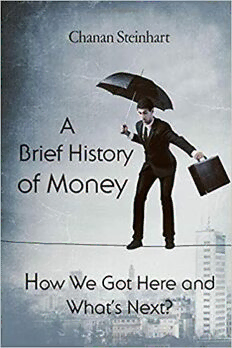Table Of ContentA Brief History of Money
A Brief History of Money
How We Got Here and What’s Next
Chanan Steinhart
Market Street Publishing
San Francisco
2015
To Anat
With thanks for the friendship and support over the years
Copyright © 2014 by Chanan Steinhart
All rights reserved
Published in 2015 in the United States of America by Market Street
Publishing
No part of this book may be reproduced without written permission except
for single quotations that are shorter than 400 words and which include
credit to the source of such quotation, in condition that no more than a
total of two quotations are used per publication.
For information about permission to reproduce or translate this book or
sections of it, please email [email protected]
Cover design: Leana mippieArt. Cover image: Shutterstock
Library of Congress Cataloging-in-Publishing Data
Steinhart, Chanan.
A brief history of money: How we got here and what’s next/ Chanan
Steinhart
p.cm
Including bibliographical references and indexes.
ISBN 978-0-990-84730-4
US History 2. World History I. Title.
2014920563
10 9 8 7 6 5 4 3 2 1
Stand Beside Her
Table of Contents
Introduction���������������������������������������������������������������������������9
“And there was evening, and there was morning”
How did all this come about? ����������������������������������������������11
“Big is Better,” or Is It? ���������������������������������������������������������23
Cash or Credit? �������������������������������������������������������������������43
The Secret Weapon: Not All Taxes Are Created Equal �������57
The Birth of the Money Creation Machine �������������������������71
The Illegitimate Child: Lender of Last Resort ��������������������97
A Sabre Dance—Gold and Paper ��������������������������������������117
A World Off Balance: Between Two Wars ������������������������135
The Golden Dollar: the Bretton Woods System ����������������167
Bye-Bye, Gold; Hello, Fiat Money ������������������������������������181
2008: A Peek at Hell ���������������������������������������������������������249
What’s Next? ���������������������������������������������������������������������283
NOTES �����������������������������������������������������������������������������325
Acknowledgments �������������������������������������������������������������349
Introduction
My love of history was passed down to me from my grandfather�
He was born in Germany, proud of the country that genera-
tions of his ancestors had called home� In 1914 he and his four
brothers gladly joined the German army to fight its war� He
was wounded and one of his brothers was killed�
I am sure he never imagined that only twenty years later his
nine-year-old daughter would be rushed out of the country
with only the clothes on her body� She was being saved by
the former enemy, the English, in what came to be known as
the Kindertransport, a rescue mission of predominantly Jewish
children organized in the lead-up to World War II� She would
survive her father� He was killed in the Theresienstadt concen-
tration camp, exactly thirteen years from the day I was born to
his refugee daughter� Although I would never meet him, his and
his family’s fate made history a prime area of interest in my life�
When I was young, I was fascinated by the war and the
Holocaust and read extensively about what had happened� As
time went on, I became more interested in people than in events,
trying to comprehend not what happens, but why� This question
expanded the scope of my study well beyond WWII Europe�
Human history is mostly the study of human group behavior�
It is like an onion: examination of a layer inevitably leads you
to another layer, deeper into history�
In the summer of 2008, a major financial event took place�
I felt that the truth of the events was not being accurately and
sufficiently represented by the standard media outlets� Thus I
went out on a quest to better understand�
As I delved into the subject, I came to the realization that
2008 was much more than a periodical market downturn as the
media and politicians often depicted it� Rather, the financial
9
crisis was a watershed moment in the history of money, one
characterized by intrigue, greed and innovation� I also con-
cluded that you cannot really understand the world we live in
without understanding the history of money, an amazing tool
invented some 6,500 years ago� Without such understanding we
are like the six blind men trying to figure out what an elephant
is by feeling different parts of the animal and coming to wildly
different conclusions�
Though history tends to surprise us with unexpected events,
it is more because of our physiological makeup that we are sur-
prised than for lack of information� Thus, painting a clear and
comprehensive big picture of money, its history and where we
stand today is the main goal of this book, if not for the gener-
ation that brought us to this point, then for the benefit of the
growing one soon to face an uncertain future�
This book is not for economists and it is not about the bits
and pieces of economic theory, though you cannot cover the
history of money without touching upon some important high-
lights of economics� The book also does not strive to be an
encyclopedia of money� Rather it is an overview, designed to
give an idea of the big picture, of the elephant�

